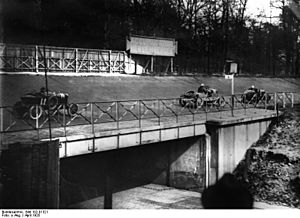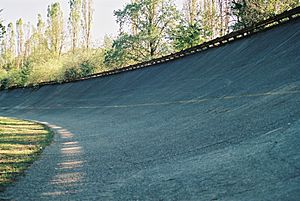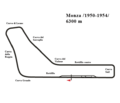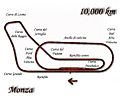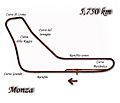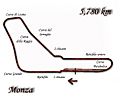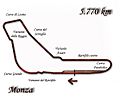Monza Circuit facts for kids
| The Temple of Speed | |
|---|---|
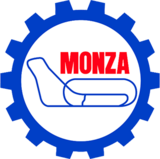
|
|
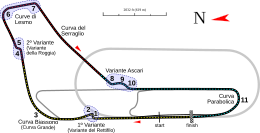
Modern Grand Prix Circuit (2000–present)
|
|
| Location | Monza, Italy |
| Time zone | CET (UTC+1) CEST (DST) |
| Coordinates | 45°37′14″N 9°17′22″E / 45.62056°N 9.28944°E |
| Capacity | 118,865 |
| FIA Grade | 1 |
| Owner | Comune di Monza & Milano |
| Operator | SIAS S.p.A. |
| Broke ground | 15 May 1922 |
| Opened | 3 September 1922 |
| Architect | Alfredo Rosselli |
| Former names | Autodromo Nazionale di Monza (1965–1974, 1983–present) Autodromo di Monza (1928–1964, 1975–1982) Circuito di Milano (1922–1927) |
| Major events | Current: Formula One Italian Grand Prix (1950–1979, 1981–present) GT World Challenge Europe (2013–2019, 2021, 2023–present) TCR World Tour (2025) Monza Rally Show (1978–2000, 2003–2021, 2023–present) Former: FIA WEC and predecessors 6 Hours of Monza (1949–1988, 1990–1992, 1995–2001, 2003–2005, 2007–2008, 2021–2023) Grand Prix motorcycle racing Italian motorcycle Grand Prix (1949–1968, 1970–1971, 1973, 1981, 1983, 1986–1987) World SBK (1990, 1992–1993, 1995–2013) FIM EWC (1964–1965, 1985, 1987) WTCC Race of Italy (2005–2008, 2010–2013, 2017) Race of Two Worlds (1957–1958) |
| Modern Grand Prix Circuit (2000–present) | |
| Surface | Asphalt |
| Length | 5.793 km (3.600 mi) |
| Turns | 11 |
| Race lap record | 1:21.046 (159.91 mph (257.35 km/h)) ( |
| Motorcycle Circuit (2010–present) | |
| Surface | Asphalt |
| Length | 5.777 km (3.590 mi) |
| Turns | 11 |
| Race lap record | 1:42.229 ( |
| Junior Course (1959–present) | |
| Surface | Asphalt |
| Length | 2.405 km (1.494 mi) |
| Turns | 4 |
| Race lap record | 0:54.300 ( |
| Grand Prix Circuit (1996–1999) | |
| Surface | Asphalt |
| Length | 5.770 km (3.585 mi) |
| Turns | 14 |
| Race lap record | 1:24.808 ( |
| Grand Prix Circuit (1994–1995) | |
| Surface | Asphalt |
| Length | 5.834 km (3.625 mi) |
| Turns | 14 |
| Race lap record | 1:24.808 ( |
| Grand Prix Circuit (1976–1993) | |
| Surface | Asphalt |
| Length | 5.800 km (3.604 mi) |
| Turns | 14 |
| Race lap record | 1:23.575 ( |
| Grand Prix Circuit (1974–1976) | |
| Surface | Asphalt |
| Length | 5.780 km (3.592 mi) |
| Turns | 11 |
| Race lap record | 1:29.600 ( |
| Grand Prix Circuit (1972–1973) | |
| Surface | Asphalt |
| Length | 5.775 km (3.580 mi) |
| Turns | 11 |
| Race lap record | 1:21.900 ( |
| Grand Prix Circuit (1955–1959, 1962–1971) Motorcycle Circuit (1955–1973) |
|
| Surface | Asphalt |
| Length | 5.750 km (3.573 mi) |
| Turns | 7 |
| Race lap record | 1:23.800 ( |
The Monza Circuit (in Italian: Autodromo Nazionale di Monza) is a famous 5.793 km (3.600 mi) race track located near the city of Monza, north of Milan, in Italy. It was built in 1922, making it one of the oldest motor racing circuits in the world. Only Brooklands and Indianapolis are older.
Monza is best known for hosting the Italian Grand Prix, a major Formula One race. This event has been held there almost every year since 1949. The circuit is often called "the Temple of Speed" because of its long straight sections and very fast corners.
The circuit is inside the beautiful Royal Villa of Monza park. It has three main tracks: the 5.793 km (3.600 mi) Grand Prix track, a shorter 2.405 km (1.494 mi) Junior track, and a 4.250 km (2.641 mi) high-speed oval. The oval track has steep, banked corners and was restored in the 2010s after being unused for many years.
Some of the most famous parts of the main Grand Prix track include the Curva Grande, the Curva di Lesmo, the Variante Ascari, and the Curva Alboreto. The Curva Grande is a very fast corner that Formula One cars usually take at full speed.
Besides Formula One, Monza has hosted many other exciting races. These include endurance sports car races and motorcycle Grand Prix events. Today, it hosts races like the Blancpain GT Series Endurance Cup and various Italian championships. It even hosted part of the 2020 World Rally Championship in 2020.
Monza is not just for cars and motorcycles. It also hosts cycling and running events. For example, Nike chose Monza for its Breaking2 event, where runners tried to finish a marathon in under two hours.
Because Monza is such a fast track, it has seen many accidents over the years. To make it safer, the track has been changed many times. New sections have been added to slow cars down, and safety areas have been improved.
Contents
History of the Monza Circuit
Building the Track
Construction of the first track began in May 1922 and finished in July of the same year. About 3,500 workers helped build it. The Milan Automobile Club paid for the project. They also created a company called SIAS to manage the track.
The original track was 10.000 km (6.214 mi) long. It had a 4.490 km (2.790 mi) loop and a 5.500 km (3.418 mi) road track. Monza officially opened on September 3, 1922. The first race, the second Italian Grand Prix, was held just a week later. Monza's location near Milan made it a great spot for racing.
Early Track Changes and Safety
In 1928, a serious accident occurred during the 1928 Italian Grand Prix. This led to changes in how races were held. For a few years, Grand Prix races only used the high-speed loop.
More accidents happened in 1933, which led to further track modifications. The layout was changed to include temporary chicanes (sections designed to slow cars down). These changes aimed to make racing safer.
Between 1938 and 1939, the circuit underwent major rebuilding. New stands and entrances were added, and the track was resurfaced. The old high-speed ring was removed, and two new bends were added. This created a Grand Prix lap of 6.300 km (3.915 mi). Racing stopped during World War II, and parts of the track were damaged. It was repaired in 1948, and races started again.
The High-Speed Oval Track
In 1954, Monza was completely updated. A new 5.750 km (3.573 mi) road course was built. Also, a new 4.250 km (2.641 mi) high-speed oval with steeply banked corners was added. These two tracks could be combined to form a 10 kilometres (6.214 mi) long circuit.
The Automobile Club of Italy hosted special "Race of Two Worlds" events. These races tried to pit American IndyCars against European Formula One and sports cars. They were held on the oval in 1957 and 1958. American cars usually dominated these races.
Formula One used the 10.000 km (6.214 mi) combined track for a few years in the 1950s and early 1960s. However, the high speeds on the oval were considered too dangerous. After a tragic accident in 1961, Formula One stopped using the oval section.
The oval track still exists today, though it is no longer used for major races. It is sometimes used for events like the Monza Rally.
Modernizing the Circuit for Safety
As racing cars and motorcycles became faster, more changes were made to Monza. In 1972, two chicanes were added to slow down the cars. These were the Variante del Rettifilo and the Variante Ascari. The track length became 5.755 km (3.576 mi).
Motorcycle racing also saw serious accidents in 1973, leading to a break from Monza until 1981. The chicanes were improved in 1974 and 1976 to be more effective. Run-off areas were also extended to make the track safer.
In 1979, more safety measures were added. These included new kerbs, larger run-off areas, and tyre barriers. The pit area was also improved to hold more cars. These changes helped bring world championship motorcycling back to Monza in 1981.
Following major safety concerns in motorsport in the 1990s, Monza's main curves were modified. This created larger gravel traps and shortened the lap to 5.770 km (3.585 mi). In 2000, the chicane on the main straight was changed to reduce accidents at the start of races. Sadly, a safety worker was injured in an accident involving flying debris during the 2000 Italian Grand Prix, leading to further safety improvements.
In 2007, the gravel run-off area at the second chicane was replaced with asphalt. The current track length is 5.793 km (3.600 mi). In 2016, there were plans for a new first bend, but these were put on hold. Before the 2024 Italian Grand Prix, the entire track was resurfaced, and facilities were improved.
A Lap of Monza in a Formula One Car
Monza is famous for being a very fast track. It has long straight sections and tight chicanes. This design means cars spend almost 80% of the lap at full throttle. This makes it very tough on engines.
Formula One cars reach incredible speeds here, often over 350 km/h (220 mph). Drivers use special car setups with small wing angles. This helps reduce drag and allows for maximum speed on the straights.
A lap starts with cars approaching the first corner at about 340 km/h (210 mph). They brake hard for the Variante del Rettifilo chicane. This corner is often where accidents happen at the start of a race.
After the first chicane, cars speed through the Curva Grande. Then they brake again for the Variante della Roggia chicane. This second chicane is a great place for drivers to try and overtake each other.
Next are the Curve di Lesmo, two challenging corners. The first one is blind, meaning drivers can't see the exit until they are in it. Getting a good exit from these corners is important for speed.
The Variante Ascari is a tricky series of turns. It's a key part of setting a fast lap time. Finally, drivers face the Curva Parabolica Alboreto. They approach it at 335 km/h (208 mph) and accelerate out onto the main straight. A good exit here can help a driver get a slipstream from another car, creating an overtaking chance.
Formula One cars experience strong forces when braking and turning at Monza. The track is mostly flat, but there's a slight downhill section towards the Variante Ascari.
Lap Records at Monza
Lewis Hamilton set the fastest pole position lap at Monza in 2020. He completed a lap in 1:18.887, averaging 264.362 km/h (164.267 mph). This is the fastest average lap speed ever recorded in qualifying for a World Championship event.
The official race lap record for the current circuit layout is 1:21.046. This was set by Rubens Barrichello in a Ferrari F2004 during the 2004 Italian Grand Prix.
Here are some of the fastest official race lap records at Autodromo Nazionale di Monza:
| Category | Driver | Vehicle | Time | Event |
|---|---|---|---|---|
| Grand Prix Circuit (2000–present): 5.793 km | ||||
| Formula One | Ferrari F2004 | 1:21.046 | 2004 Italian Grand Prix | |
| FIA F2 | Dallara F2 2024 | 1:32.717 | 2024 Monza Formula 2 round | |
| LMP1 | Peugeot 908 HDi FAP | 1:32.449 | 2008 1000 km of Monza | |
| LM GTE | Ferrari 488 GTE Evo | 1:45.947 | 2022 6 Hours of Monza | |
| GT3 | Ferrari 296 GT3 | 1:44.593 | 2024 3 Hours of Monza | |
| Superbike | Ducati 1098R | 1:45.336 | 2009 Monza World SBK round | |
| Motorcycle Circuit (2010–present): 5.777 km | ||||
| World SBK | Kawasaki Ninja ZX-10R | 1:42.229 | 2013 Monza World SBK round | |
| Junior Course (1959–present): 2.405 km | ||||
| Group 5 | Porsche 934/76 | 0:54.300 | 1976 Monza Group 5 round | |
| Grand Prix Circuit (1996–1999): 5.770 km | ||||
| Formula One | McLaren MP4/12 | 1:24.808 | 1997 Italian Grand Prix | |
| Grand Prix Circuit (1994–1995): 5.834 km | ||||
| Formula One | Williams FW16B | 1:25.930 | 1994 Italian Grand Prix | |
| Grand Prix Circuit (1976–1993): 5.800 km | ||||
| Formula One | Williams FW15C | 1:23.575 | 1993 Italian Grand Prix | |
| Grand Prix Circuit (1974–1976): 5.780 km | ||||
| Group 6 prototype | Renault Alpine A442 | 1:29.600 | 1976 Monza 4 Hours | |
| Grand Prix Circuit (1972–1973): 5.775 km | ||||
| Group 5 prototype | Matra-Simca MS670 | 1:21.900 | 1973 1000km of Monza | |
| Grand Prix Circuit (1955–1959, 1962–1971) Motorcycle Circuit (1955–1973): 5.750 km |
||||
| F1 | March 711 | 1:23.800 | 1971 Italian Grand Prix | |
| Oval Circuit (1955–1971): 4.250 km | ||||
| USAC Indycar | Kurtis Kraft 500G-Offenhauser | 0:54.000 | 1958 Race of Two Worlds | |
| Combined Circuit (1955–1971): 10.000 km | ||||
| F1 | Ferrari 246 F1 | 2:43.600 | 1960 Italian Grand Prix | |
| Grand Prix Circuit (1948–1954): 6.300 km | ||||
| F1 | Alfa Romeo 159M | 1:56.200 | 1951 Italian Grand Prix | |
| Florio Circuit (1938–1949): 6.993 km | ||||
| GP | Mercedes-Benz W154 | 2:34.200 | 1938 Italian Grand Prix | |
| Florio Circuit with Temporary Chicanes (1935–1937): 6.952 km | ||||
| GP | Alfa Romeo Monoposto Tipo-C "8C-35" | 2:49.800 | 1935 Italian Grand Prix | |
| Grand Prix Circuit (1934): 4.330 km | ||||
| GP | Auto Union Type A | 2:13.600 | 1934 Italian Grand Prix | |
| Original Grand Prix Circuit (1922–1933): 10.000 km | ||||
| GP | Alfa Romeo P3 | 3:13.200 | 1933 Italian Grand Prix | |
Previous Track Layouts
Events Held at Monza
Monza hosts many exciting racing events throughout the year.
- Current Events
- March: Ferrari Challenge Europe
- April: F2000 Italian Formula Trophy Monza Historic
- June: GT World Challenge Europe, TCR World Tour, Lamborghini Super Trofeo Europe, Italian GT Championship, TCR Italian Series, Italian F4 Championship, Indy Autonomous Challenge, McLaren Trophy Europe
- July: Eurocup-3, BOSS GP
- September: Formula One Italian Grand Prix, FIA Formula 2 Championship Monza Formula 2 round, FIA Formula 3 Championship, Porsche Supercup
- October: International GT Open, Euroformula Open Championship, Formula Regional European Championship, Euro 4 Championship, GB3 Championship, Renault Clio Cup Europe, GT Cup Open Europe, Porsche Carrera Cup Italia
- December: Monza Rally Show
- Future Events
- GT2 European Series (2026)
- GT4 European Series (2026)
- Past Events
Monza has a long history of hosting many different types of races, including:
- 24H Series (12 Hours of Monza)
- Auto GP
- BMW M1 Procar Championship
- European Le Mans Series (4 Hours of Monza)
- European Touring Car Championship
- FIA World Endurance Championship (6 Hours of Monza)
- Grand Prix motorcycle racing (Italian motorcycle Grand Prix)
- International Formula 3000
- Superbike World Championship
- World Rally Championship (Rally Monza)
- World Touring Car Championship (FIA WTCC Race of Italy)
Monza also hosted the special Nike Breaking2 event.
See also
 In Spanish: Autodromo Nazionale di Monza para niños
In Spanish: Autodromo Nazionale di Monza para niños



